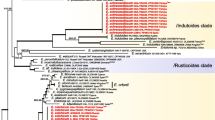Abstract
Pentaplaris davidsmithii from Peru and Bolivia andP. huaoranica from Ecuador are described and compared to the only other species previously known in the genus,P. doroteae from Costa Rica. Morphological and palynological characters support the inclusion ofPentaplaris in core Malvales while suggesting that the original assumption that the genus belonged in Tiliaceae-Brownlowieae cannot be maintained.Pentaplaris, which comprises three isolated and evidently rare species, probably belongs to the malvoid-bombacoid alliance, but its position within this clade ramains unresolved.
Similar content being viewed by others
Literature Cited
Allen, P. H. 1956. The rain forest of Golfo Dulce. University of Florida Press, Gainesville.
Alverson, W. S., K. G. Karol, D. A. Baum, M. W. Chase, S. M. Swensen, R. McCourt &K. J. Sytsma. 1998. Circumscription of the Malvales and relationships to other Rosidae: evidence fromrbcL sequence data. Amer. J. Bot. 85: 876–887.
Alverson, W. S., B. A. Whitlock, R. Nyffeler, C. Bayer & D. A. Baum. Phylogeny of the core Malvales: evidence fromndhF sequence data. Amer. J. Bot. (in press).
Baker, H. G. &I. Baker. 1968. Chromosome numbers in the Bombacaceae. Bot. Gaz. 129: 294–296.
Bakhuizen van den Brink, R. C. 1924. Revisio Bombacacearum. Bull. Jard. Bot. Buitenzorg. Sér. 3 6: 161–240.
Barnett, L. C. 1988. Systematics ofNesogordonia Baillon (Sterculiaceae). Ph.D. dissertation. University of Texas, Austin.
Bayer, C. 1999. The bicolor unit—homology and transformation of an inflorescence structure unique to core Malvales. Pl. Syst. Evol. 214: 187–198.
Bayer, C., M. F. Fay, A. Y. de Bruijn, V. Savolainen, C. M. Morton, K. Kubitzki, W. S. Alverson & M. W. Chase. Support for an expanded family concept of Malvaceae within a recircumscribed order Malvales: a combined analysis of plastidatpB andrbcL DNA sequences. J. Linn. Soc. Bot. (in press).
Christensen, P. B. 1986. Pollen morphological studies in the Malvaceae. Grana 25: 95–117.
Croft, J. R. 1981. Bombacaceae.In: E. E. Henty, editor. Handb. Fl. Papua New Guinea 2: 4–18.
Erdtman, G. 1952. Pollen morphology and plant taxonomy. Almqvist & Wiksell, Stockholm.
Fryxell, P. A. 1968. A redefinition of the tribe Gossypieae. Bot. Gaz. 129: 296–303.
— 1979. The natural history of the cotton tribe. Texas A&M University Press, College Station.
— 1988. Malvaceae of Mexico. Syst. Bot. Monogr. 25: 1–522.
Fuchs, H. 1967. Pollen morphology of the family Bombacaceae. Rev. Palaeobot. Palynol. 3: 119–132.
Gibbs, P. E., J. Semir &N. D. Da Cruz. 1988. A proposal to unite the generaChorisia Kunth andCeiba Miller (Bombacaceae). Not. Roy. Bot. Gard. Edinburgh 45: 125–136.
Gunn, C. R., J. H. Wiersema, C. A. Ritchie &J. H. Kirkbride Jr. 1992. Families and genera of spermatophytes recognized by the Agricultural Research Service. Techn. Bull. U.S.D.A. 1796: 1–500.
Hammel, B. & N. Zamora. 1998. Manual de las plantas de Costa Rica. Electronic publication, available at <http://www.mobot.org/manual.plantas/>
Hutchinson, J. 1967. The genera of flowering plants (Angiospermae). Dicotyledones. Vol. 2. Clarendon Press, Oxford.
Judd, W. S. &S. Manchester. 1997. Circumscription of Malvaceae (Malvales) as determined by a preliminary cladistic analysis of morphological, anatomical, palynological, and chemical characters. Brittonia 49: 384–405.
Metcalfe, C. R. &L. Chalk. 1957. Anatomy of the dicotyledons. Vol. 1. Clarendon Press, Oxford.
Nilsson, S. &A. Robyns. 1986. Bombacaceae Kunth. World Pollen Spore Fl. 14: 1–59.
Parker, T. A., III & B. Bailey, editors, 1991. A biological assessment of the Alto Madidi region and adjacent areas of Northwest Bolivia, May 18–June 15, 1990. RAP Working Papers 1: 1–108.
Presting, D., H. Straka &B. Friedrich. 1983. Palynologia Madagassica et Mascarenica, Familien 128 bis 146. Trop. Subtrop. Pflanzenwelt 44: 1–93.
Robyns, A. 1963. Essai de monographie du genreBombax s.l. (Bombacaceae). Bull. Jard. Bot. État 33: 1–315.
— 1971. On pollen morphology of Bombacaceae. Bull. Jard. Bot. Belg. 41: 451–456.
Schumann, K. 1895. Tiliaceae, Malvaceae, Bombacaceae, Sterculiaceae. Pages 8–99.In: A. Engler & K. Prantl, editors. Die natürlichen Pflanzenfamilien, 3(6).
Sharma, B. D. 1969. Pollen morphology of Tiliaceae in relation to plant taxonomy. J. Palynol. 5: 7–29.
Smith, D. N. 1988. Flora and vegetation of the Huascaran National Park, Ancash, Peru, with preliminary taxonomic studies for a manual of the flora. Ph.D. dissertation. Iowa State University, Ames.
Spjut, R. W. 1994. A systematic treatment of fruit types. Mem. New York Bot. Gard. 70: 1–182.
Troll, W. 1933. XII.Camptostemon Schultzii Mast. andCamptostemon philippinensis (Vid.) Becc. als neue Vertreter der austral-asiatischen Mangrovevegetation. Flora 28: 348–360.
Williams, L. O. &P. C. Standley. 1952.Pentaplaris, a new genus of Tiliaceae from Costa Rica. Ceiba 3: 139–142.
Author information
Authors and Affiliations
Rights and permissions
About this article
Cite this article
Bayer, C., Dorr, L.J. A synopsis of the neotropical genus Pentaplaris, with remarks on its systematic position within core Malvales. Brittonia 51, 134–148 (1999). https://doi.org/10.2307/2666620
Issue Date:
DOI: https://doi.org/10.2307/2666620




